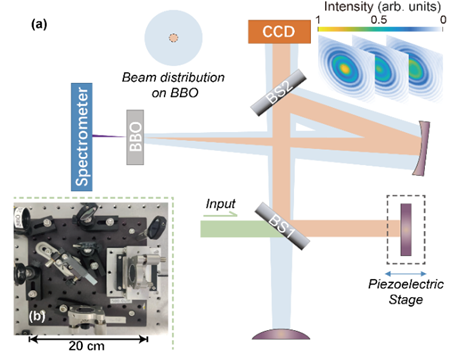Ultrashort laser pulses with temporal durations down to the few-cycle regime have now been widely used in a variety of research areas, including ultrafast spectroscopy, high harmonic generation, and laser plasma accelerators. Several techniques have been developed for temporal characterization of few-cycle laser pulses but few of them can be directly used to resolve the complete spatiotemporal information of the laser profile.
Recently, the research group from Shanghai Institute of Optics and Fine Mechanics, Chinese Academy of Sciences, demonstrated a modified self-referenced Spatio-temporal characterization set-up termed TERMITES-X-FROG, which provides a practical and efficient means of measuring 3D Spatio-temporal information of few-cycle pulses. The result was published in Optics Letters Sep. 15, 2020.
While conventional self-referenced interferometers were widely used to retrieve the spatial profile of the relative spectral phase of pulses, additional measurements of temporal and spectral information at a particular position of the laser beam were, however, necessary to remove the indeterminacy, which increases the system complexity. In this study, researchers integrate an interferometric frequency-resolved optical gating (FROG) with a radial shearing Michelson interferometer.
In the measurements, interferograms captured by CCD were used to reconstruct the multispectral wavefront of the laser beam. Meanwhile, the collinear X-FROG trace was used to reconstruct the spectral phase at the centroid of the beam. Using these results, the complete spatiotemporal information of the 9.7-fs pulses was successfully reconstructed over a single scan of the interferometer arm.
This work was supported by the National Key R&D Program of China, the National Natural Science Foundation of China, the Program of Shanghai Academic/Technology Research Leader, the Strategic Priority Research Program of the Chinese Academy of Sciences, and the Major Project Science and Technology Commission of Shanghai Municipality.

(a)Schematic diagram of the measurement device. The reflecting surface of the beam splitter (BS) is marked as black. (b) Photo of the device. (Image by SIOM)
Article website:
https://www.osapublishing.org/ol/abstract.cfm?uri=ol-45-18-5081
Contact:
WU Xiufeng
General Administrative Office
Shanghai Institute of Optics and Fine Mechanics, CAS
Email: xfwu@siom.ac.cn
Web: http://english.siom.cas.cn/